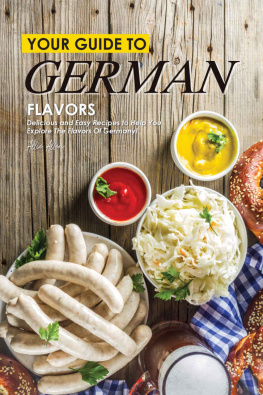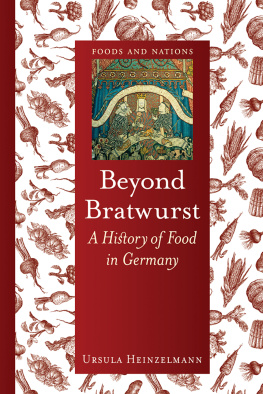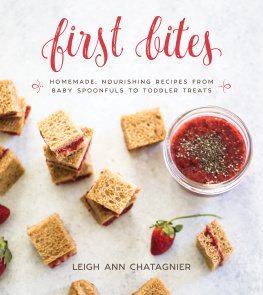Hassani - Spoonfuls of Germany: German Regional Cuisine
Here you can read online Hassani - Spoonfuls of Germany: German Regional Cuisine full text of the book (entire story) in english for free. Download pdf and epub, get meaning, cover and reviews about this ebook. year: 2015, publisher: Back Road Press, genre: Home and family. Description of the work, (preface) as well as reviews are available. Best literature library LitArk.com created for fans of good reading and offers a wide selection of genres:
Romance novel
Science fiction
Adventure
Detective
Science
History
Home and family
Prose
Art
Politics
Computer
Non-fiction
Religion
Business
Children
Humor
Choose a favorite category and find really read worthwhile books. Enjoy immersion in the world of imagination, feel the emotions of the characters or learn something new for yourself, make an fascinating discovery.

- Book:Spoonfuls of Germany: German Regional Cuisine
- Author:
- Publisher:Back Road Press
- Genre:
- Year:2015
- Rating:5 / 5
- Favourites:Add to favourites
- Your mark:
- 100
- 1
- 2
- 3
- 4
- 5
Spoonfuls of Germany: German Regional Cuisine: summary, description and annotation
We offer to read an annotation, description, summary or preface (depends on what the author of the book "Spoonfuls of Germany: German Regional Cuisine" wrote himself). If you haven't found the necessary information about the book — write in the comments, we will try to find it.
Hassani: author's other books
Who wrote Spoonfuls of Germany: German Regional Cuisine? Find out the surname, the name of the author of the book and a list of all author's works by series.
Spoonfuls of Germany: German Regional Cuisine — read online for free the complete book (whole text) full work
Below is the text of the book, divided by pages. System saving the place of the last page read, allows you to conveniently read the book "Spoonfuls of Germany: German Regional Cuisine" online for free, without having to search again every time where you left off. Put a bookmark, and you can go to the page where you finished reading at any time.
Font size:
Interval:
Bookmark:

Irma Rombauers monumental The Joy of Cooking begins with an epigraph from Goethes Faust: That which thy fathers have bequeathed to thee, earn it anew if thou wouldst possess it. When I attended high school in Frankfurt am Main, Goethes hometown, I studied Faust inside and out, but I never thought that this sentence would reveal its wisdom and truth to me through German food and by writing this cookbook.
I grew up in Germany in a bicultural family. Between my father, an immigrant from Tunisia, and my mother, a native of Westphalia, the meals we ate at home were eclectic, consisting of whatever my mother could assemble for dinner after a long day in the office. Most days we would have quick and easy meals: steak, pasta, and a salad. We never had fast food or frozen dinners. There was not much fast food available in Germany at the time. But that did not matter, because my mother deeply detests ready-made food. She still recalls with disgust the day we had just moved into a new apartment and she, as a last resort, warmed up ravioli straight from the can.
The few typical German dishes we had at home were Grnkohl (kale stew), which as a child I dreaded (not any more!), and Rouladen (beef roll-ups), which I loved (and still do). My maternal grandmother Lydia introduced me to a number of traditional German dishes when I came to her for lunch after school. She made me potato pancakes and filling bread puddings, which I preferred over the daily regimen of meat at home. At Christmas, she baked a variety of cookies, and for special family occasions she made a Black Forest cake so good no pastry shop version has ever fully satisfied me.
Except for these few goodies, I was not very fond of the traditional German foods I knew as a child. After family gatherings in my mothers native Westphalia, I complained to my parents about the old-fashioned, uncool, and bland home cooking. My mixed genes and struggle with a bicultural identity, I am sure, also contributed to my indifference towards German foods.
The summer I graduated from high school, I helped out in my mothers cousins upscale restaurant in Caracas, Venezuela. This experience marked the beginning of my serious interest in cooking. For two decades, I explored the cuisines of many lands and cultures, but, with the exception of a few cakes and other desserts, I treated Germany as a blank spot on my culinary map.
Ironically, my emigration to the United States in 1998 brought me closer to German cooking. Moving to America meant the loss of most of my cultural references practically overnight. I felt this even more when I met my husband, and his two young children. I had not read the same books as a child, did not know their nursery rhymes, had never eaten macaroni and cheese, and had not a clue about who or what a Sloppy Joe is. I realized that catching up to the American lifestyle and culture would take forever and would always remain a patchwork since I could not turn back the clock. So I decided to turn the tables and introduce a few elements of my own culture into my new world. This, I hoped, would have the double effect of widening the horizon of my new family and fighting my occasional attacks of homesickness (which creep up on me especially during holidays).
My craving for German foods set in not long after I came to America. Before my visits to Germany, I send my mother a wish list of German dishes. I also started to do what many expatriates do: with each trip home, I bring back a few ingredients that are difficult or impossible to find in the United States. Its amazing how German food is all I can think about during the eight-hour plane trip from Newark to Frankfurt.
For the first two years after I came to the United States, I worked as an editor at Hippocrene Books. The publisher, George Blagowidow, hired me fresh-off-the-boat. Five years later, George must have been reading my mind when he asked me to write about German regional food. Writing this cookbook helped me rediscover my roots without leaving my home in America.
In this book, I take an approach different from most German regional cookbooks. The recipes are arranged into four regions: North, East, West, and South, rather than into the sixteen German federal states. While all regions have their distinctive food traditions, clear culinary borders within the regions are often difficult to draw, because many dishes have traveled around and have become popular in neighboring states, often with slight variations and under different names.
I discovered an abundance of German regional dishes, many of which were new to me. It thrilled me to learn that German cuisine has so much variety. Selecting the recipes for this book was therefore no easy task, and I realized very quickly that drawing a complete culinary map of Germany would be impossible. I primarily picked dishes that I find tasty. The 200 recipes in this book are an eclectic and personal selection that carries no claim to completeness.
My criteria for selecting recipes were driven by several considerations. I wanted to honor the food pyramid and find a reasonable balance between dishes with heavy meat content and those with little or no meat. True to its reputation, German cuisine does include a lot of meat dishes, especially pork. As well, I only included recipes with ingredients that are easily available in North American supermarkets and specialty food stores. Whenever possible, I provided alternatives and substitutes for typical German ingredients. I sacrificed several deserving dishes because I did not want to frustrate the cook and send her or him on a shopping odyssey.
Delving into the foods of Germany and the history and stories behind them gave me tremendous pleasure. If you enjoy these recipes half as much as I enjoyed preparing and writing them, I will be very satisfied.
When I originally worked on this book in 2003, new cookbooks about German cuisine in German were far and few. Today, ten years later, almost every region, era, and topic has its own cookbook: from farmhouse cooking to cooking with local ingredients, from cookbooks by celebrity chefs like Alfons Schuhbeck to food and recipe memoirs about the lost world of Eastern Prussia, and cookbooks celebrating and reinterpreting the once shunned socialist fare of the German Democratic Republic. Although one swallow (the bird, that is) does not make a summer, something of a renaissance is afoot. Diners are rediscovering German cuisine and polishing its reputation.
For the longest time, German cuisine had a bad image, as much within Germany as in the rest of the world. German gourmet food was viewed as an oxymoron. Either you ate gourmet food, or you ate German food, but the two did not go together.
While the French and Italians adore their cuisine and freely rave about it, the majority of Germans turn their noses up at German food. The reason for this disdain is not so much that German food really fits its stereotype of being heavy, fatty, and lacking refinement; the disdain actually runs deeper than their stomachs. The explanation lies in the history of the first half of the twentieth century, especially the twelve dark and somber years when Germany set out to dominate the world.
Over the past six decades, Germany has recovered from World War II on many levels. Although the country has been completely rebuilt, the damage to the cultural identity of the German people has yet to be fully repaired. After the war, being patriotic and proud of ones German heritage was looked down on because it was inextricably linked to the extreme nationalism of the Third Reich. The general mood included a feeling of low self-esteem. Celebrating German culinary traditions ran counter to the national psyche. Instead, in the postwar years, Germans opened their kitchens and their mouths to the cuisines of other countries. Almost every German home cook I know can make minestrone and tiramis but most have never cooked a semolina dumpling soup or a red berry pudding from scratch. Nearly everyone in Germany has a wok but hardly anyone owns a spaetzle press.
Font size:
Interval:
Bookmark:
Similar books «Spoonfuls of Germany: German Regional Cuisine»
Look at similar books to Spoonfuls of Germany: German Regional Cuisine. We have selected literature similar in name and meaning in the hope of providing readers with more options to find new, interesting, not yet read works.
Discussion, reviews of the book Spoonfuls of Germany: German Regional Cuisine and just readers' own opinions. Leave your comments, write what you think about the work, its meaning or the main characters. Specify what exactly you liked and what you didn't like, and why you think so.







